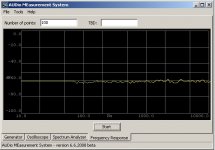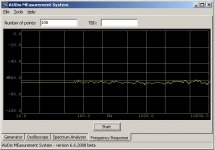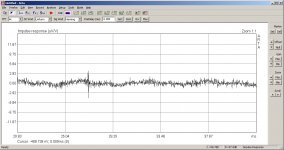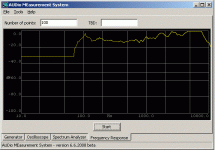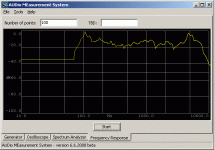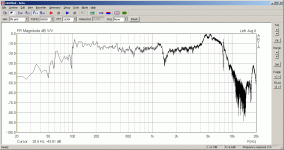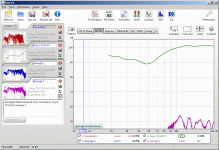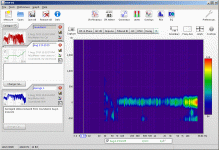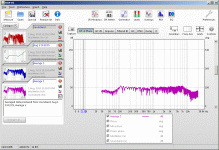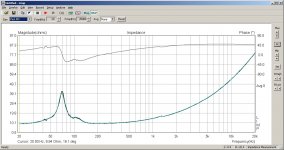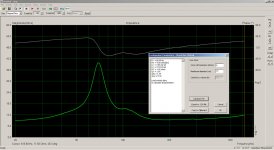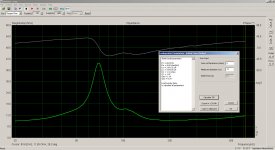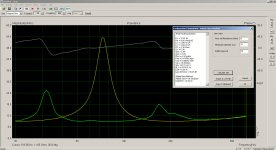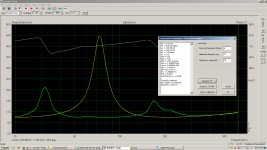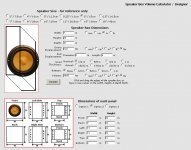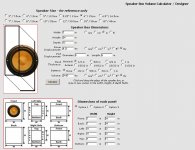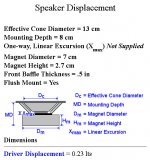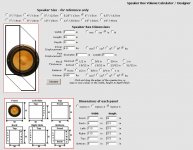Given the size of your room (and I hope it is only temporary), and that you are happy with the sound as they are, I suggest you keep what you have until you move to a larger situation. I cannot see where you might put speakers anywhere else in the room with the layout, particularly two adjacent doors.
My suggestion was to put the woofer in a sealed system. I think that designing a ported system by trial and error without knowing any of the parameters of the woofer would be really difficult (in achieving good reproduction).
With the technique that I proposed, all that you do is decrease the volume until Q of the woofer starts to get to be too high, evidenced by hearing a "thud" or a "plop". When you find out what the threshold volume is, then you are done with the alignment. To my mind, this isn't too bad of a technique when designing a closed box for a woofer that you know virtually nothing about.
If you frequently do measure parameters of drivers and already know how to go about it, then I agree, that isn't too much trouble. That isn't the OP's situation. If that is something that he is willing to learn to do and may use again in the future, then maybe that would be a good route for him to take.
Depending on the individual, building the test box might or might not be more time consuming than measuring the Thiele/ Small parameters. I don't know, is it possible to measure Vas with a computer program? If not, then again you need to make either a test box or add mass to the driver while taking measurements.
Regards,
Pete
Pete
If this were 25-30 years ago I would wholy support your test. It's a good test for sure. 😉 Test boxes are simple to whip up tho and easy enough to determine Vas today (see links I provided earlier). In this regard I have gone as far as buying any old junk speaker with a quality box of a certain size can be had for cheap, if not for free. I have several in storage I need to pickup just for this test when I already have the OEM specs, Peerless none the less. These were small bookshelf speakers my son blew up, VC's are not suppose to be Slinky's. 😀
Figuring if Som has the skill to build a 6 channel amp, even if in kit form simplicity, has the required will to see this go from guessing to something more optimal from the word go. Not to bunk your input at all, or to lay claim it won't work or the like. Just an observation of what I personally think he can achieve out of the gate in audio. 🙂
Will add I have a few friends that are from India with BS in electrical engineering < if he is anything like them (very intelligent) I have no doubt he could follow through with success.
When I was young had to wait til pops got home to use test equipement, he'd bring home what I needed from the shop if there was a need and only if there was a need. This left me very frustrated and was forced out of necessity to come up with other solutions and much guessing. Today we have computers, meters and microphones that can be had for little. With the largest cost already absorbed by his computer. Lets fast track this person (or anyone) to the forefront, bypassing most of the headaches. Which I might add is nothing to squander. Burned a few times and most walk away in frustration. Here we can help cultivate Som's enthusiasm by providing good solid references to achieve his goal. This is in stark contrast to how I learned. T/S was new and little of worth to the DIYer outside of what Weems and a few other had contributed at the time. Those so called "specs" were a joke for the most part. Even today those specs are raunchy in most brands.
Respected all friends,
Please carry on giving your valuable opinion. I am reading all. I will attempt all. Every post of yours is really valuable to me.
I am a slow learner. So it might take some time. 🙂
Regarding my present floor standers: They sound really awesome there is no doubt. And I am really very happy with their performance.
But it just happened by luck. I didn't know anything. I just made the box and a port in the front panel after googling a lot. I experimented with the size of the port with blind guess and found that bigger port size dramatically improved the performance or the dynamic range.
But this is the time for me to learn with all of your kind and experienced guidance.
So kindly carry on. 🙂
Oh meanwhile I just made a 5 band equalizer and a Stereo with LM3886 today. So I can learn and experience with passive X-over too after I finish this Active Speakers enclosure. 🙂
Thank you so much all from the core of my heart.
Please carry on giving your valuable opinion. I am reading all. I will attempt all. Every post of yours is really valuable to me.
I am a slow learner. So it might take some time. 🙂
Regarding my present floor standers: They sound really awesome there is no doubt. And I am really very happy with their performance.
But it just happened by luck. I didn't know anything. I just made the box and a port in the front panel after googling a lot. I experimented with the size of the port with blind guess and found that bigger port size dramatically improved the performance or the dynamic range.
But this is the time for me to learn with all of your kind and experienced guidance.
So kindly carry on. 🙂
Oh meanwhile I just made a 5 band equalizer and a Stereo with LM3886 today. So I can learn and experience with passive X-over too after I finish this Active Speakers enclosure. 🙂
Thank you so much all from the core of my heart.
Last edited:
Here is some test results with a PC condenser mic.
The mic was placed some 2 inches away from the 6.5 inches midbass woofer.
The first test ( the first photo) was done with a 3 way car speaker.
The second and third test were done with the woofer.
Not sure about the result. I cannot interpret these yet. 🙂
Reading more. 🙂
The mic was placed some 2 inches away from the 6.5 inches midbass woofer.
The first test ( the first photo) was done with a 3 way car speaker.
The second and third test were done with the woofer.
Not sure about the result. I cannot interpret these yet. 🙂
Reading more. 🙂
Attachments
Last edited:
Som, not familar with that software, but appears to me that your not seeing the woofer at all. Looks like you are measuring the noise floor.
One of the tests I use for testing mics (and setting the deviation on a single side band transciever to 5kHz) by saying 5, yes five!. Said strong and held long will yield a constant amplitude signal that's easy to see when doing tests.
One of the tests I use for testing mics (and setting the deviation on a single side band transciever to 5kHz) by saying 5, yes five!. Said strong and held long will yield a constant amplitude signal that's easy to see when doing tests.
Place the mic closer, as close as possible without touching, lets say 1cm
I'll be crashing here shortly, so have some fun with the software, read some tutorials and what not. Your doing great so far 🙂
I'll be crashing here shortly, so have some fun with the software, read some tutorials and what not. Your doing great so far 🙂
Last edited:
Place the mic closer, as close as possible without touching, lets say 1cm
I'll be crashing here shortly, so have some fun with the software, read some tutorials and what not. Your doing great so far 🙂
Thank you sir. I will do that.
I'm reading tutorials and manuals. Many things are very alien to me.
But I am giving a repeated reading and using google to get further reference.
I will post more snaps soon.
Thank you so much for the encouragement. 🙂
Respected all,
I separated the woofer chamber from the midrange section and the bass response is less boomy and there is a slight improvement in the dynamic range.... the defects of compressed mp3 sounds are more prominent now, LOL
I was checking with a ballad. It sounded great.
I think I will stick to the MLTL. I compared the sound with a normal two way speaker, but TL sounded way better to me.
Anyway, here are some snaps again, tested with my DIY MLTL 🙂 ( thank you for teaching me the term 🙂 )
Kindly check these and advise me please at your convenience.
Thank you all.
I separated the woofer chamber from the midrange section and the bass response is less boomy and there is a slight improvement in the dynamic range.... the defects of compressed mp3 sounds are more prominent now, LOL
I was checking with a ballad. It sounded great.
I think I will stick to the MLTL. I compared the sound with a normal two way speaker, but TL sounded way better to me.
Anyway, here are some snaps again, tested with my DIY MLTL 🙂 ( thank you for teaching me the term 🙂 )
Kindly check these and advise me please at your convenience.
Thank you all.
Attachments
Last edited:
Do you have the Vas, Qts, Qes, Qms, Fs values requested last week?
Measure drivers independently from a 1cm distance on center.
Cannot make heads or tails out of the above graphs. 😕
If you have built the enclosure described in your 3D models, it is incorrect. Length, depth, woofer placement and port placement are wrong. The mid and tweeter placement are dependent on driver diameter/crossover frequency/baffle width and are most likely incorrect also.
Measure drivers independently from a 1cm distance on center.
Cannot make heads or tails out of the above graphs. 😕
If you have built the enclosure described in your 3D models, it is incorrect. Length, depth, woofer placement and port placement are wrong. The mid and tweeter placement are dependent on driver diameter/crossover frequency/baffle width and are most likely incorrect also.
csom,
Measuring the parameters of each speaker must be performed with the speaker removed from any enclosure, hanging in free air, at least 0.6 meter from any surface in any direction.
Here is one link to a method:
Measuring Loudspeaker Driver Parameters
If I was an ARTA expert, I would probably be able to find an easy way to use that, to do the measurements.
Here are more:
https://www.google.com/#bav=on.2,or.r_qf.&fp=e0029cac7be12c4c&q=measure+speaker+parameters
After you have measured the Thiele-Small parameters of your drivers, then you will be able to calculate the best sizes etc for almost any type of enclosure for them.
Cheers,
Tom
Measuring the parameters of each speaker must be performed with the speaker removed from any enclosure, hanging in free air, at least 0.6 meter from any surface in any direction.
Here is one link to a method:
Measuring Loudspeaker Driver Parameters
If I was an ARTA expert, I would probably be able to find an easy way to use that, to do the measurements.
Here are more:
https://www.google.com/#bav=on.2,or.r_qf.&fp=e0029cac7be12c4c&q=measure+speaker+parameters
After you have measured the Thiele-Small parameters of your drivers, then you will be able to calculate the best sizes etc for almost any type of enclosure for them.
Cheers,
Tom
Last edited:
Do you have the Vas, Qts, Qes, Qms, Fs values requested last week?
I apologize! I completely forgot that! I will do and post again! Sorry.
I am making small stand for it to place the mic.Measure drivers independently from a 1cm distance on center.
I thought these might be useful in determining the present audio performance, decay, audio spectrum reproduction in my listening environment. But now I see I am utterly wrongCannot make heads or tails out of the above graphs. 😕
Okay sir. I will ask more to correct it after I post the required parametersIf you have built the enclosure described in your 3D models, it is incorrect. Length, depth, woofer placement and port placement are wrong. The mid and tweeter placement are dependent on driver diameter/crossover frequency/baffle width and are most likely incorrect also.
Thanks a ton for your reply.
.....
Measuring the parameters of each speaker must be performed with the speaker removed from any enclosure, hanging in free air, at least 0.6 meter from any surface in any direction................
.............
Cheers,
Tom
Thank you so much Tom!
I will read your links and execute accordingly and will report you back here.
A little progress but faced a new problem
Respected dear friends,
I read and studied innumerable sites including your posted ones.
And finally I made a jig for LIMP and now I'm able to pick up the parameters of the drivers very easily. It's really a great way to effortlessly obtain the specs.
Please accept my sincere thanks for all the encouragement and your teaching me this much-needed technical aspect.
I tested some 5 drivers. Branded and some non-branded speakers are giving desired tsp output. And I'm happy.
Now I have a problem.
I tested the non-standard mid-bass woofer that I have in my system and intend to use due to its more or less satisfactory performance so far. But here I faced a problem.
LIMP reported "bad parameters" and I was unable to obtain tsp.
Now I don't know what to do.
I tested with both the stepped sine-wave as well as Pink Noise methods. I did an overlay of both in the attached snapshot.
Kindly help me.
Thank you.
Respected dear friends,
I read and studied innumerable sites including your posted ones.
And finally I made a jig for LIMP and now I'm able to pick up the parameters of the drivers very easily. It's really a great way to effortlessly obtain the specs.
Please accept my sincere thanks for all the encouragement and your teaching me this much-needed technical aspect.
I tested some 5 drivers. Branded and some non-branded speakers are giving desired tsp output. And I'm happy.
Now I have a problem.
I tested the non-standard mid-bass woofer that I have in my system and intend to use due to its more or less satisfactory performance so far. But here I faced a problem.
LIMP reported "bad parameters" and I was unable to obtain tsp.
Now I don't know what to do.
I tested with both the stepped sine-wave as well as Pink Noise methods. I did an overlay of both in the attached snapshot.
Kindly help me.
Thank you.
Attachments
Update
I set the highest cut-off frequency to 600Hz considering the nature of the driver and it worked!
And now I got the tsp.
Parameter --------Value-------- Dim
Fs --------------68.48 ------------Hz
Re ---------------8 ---------------ohms[dc]
Le ------------1491.02 -----------uH
L2 ------------7724.29 -----------uH
R2 ----------------1.91 -----------ohms
Qt ----------------1.07 ----------------
Qes --------------1.34 -----------------
Qms -------------5.34 -----------------
Kindly check out the attachments and give your valuable advice on the next step.
Thank you all.
I set the highest cut-off frequency to 600Hz considering the nature of the driver and it worked!
And now I got the tsp.
Parameter --------Value-------- Dim
Fs --------------68.48 ------------Hz
Re ---------------8 ---------------ohms[dc]
Le ------------1491.02 -----------uH
L2 ------------7724.29 -----------uH
R2 ----------------1.91 -----------ohms
Qt ----------------1.07 ----------------
Qes --------------1.34 -----------------
Qms -------------5.34 -----------------
Kindly check out the attachments and give your valuable advice on the next step.
Thank you all.
Attachments
Last edited:
Update again
Here is the full spec of the midbass as I obtained from the test.
Kindly check it.
ADDED MASS METHOD:
Thiele-Small parameters:
Fs = 72.51 Hz
Re = 8.00 ohms[dc]
Le = 1335.43 uH
L2 = 1410.20 uH
R2 = 2.30 ohms
Qt = 0.90
Qes = 1.06
Qms = 6.04
Mms = 6.32 grams
Rms = 0.476560 kg/s
Cms = 0.000762 m/N
Vas = 18.85 liters
Sd= 132.73 cm^2
Bl = 4.657913 Tm
ETA = 0.65 %
Lp(2.83V/1m) = 90.24 dB
Added Mass Method:
Added mass = 38.00 grams
Diameter= 13.00 cm
Closed Box method:
Fs = 31.49 Hz
Re = 8.00 ohms[dc]
Le = 1497.86 uH
L2 = 2347.67 uH
R2 = 2.90 ohms
Qt = 2.22
Qes = 3.23
Qms = 7.08
Mms = -68.20 grams
Rms = -1.#IND00 kg/s
Cms = -0.000374 m/N
Vas = -9.27 liters
Sd= 132.73 cm^2
Bl = -1.#IND00 Tm
ETA = -0.01 %
Lp(2.83V/1m) = -1.#J dB
Closed Box Method:
Box volume = 38.00 liters
Diameter= 13.00 cm
Here is the full spec of the midbass as I obtained from the test.
Kindly check it.
ADDED MASS METHOD:
Thiele-Small parameters:
Fs = 72.51 Hz
Re = 8.00 ohms[dc]
Le = 1335.43 uH
L2 = 1410.20 uH
R2 = 2.30 ohms
Qt = 0.90
Qes = 1.06
Qms = 6.04
Mms = 6.32 grams
Rms = 0.476560 kg/s
Cms = 0.000762 m/N
Vas = 18.85 liters
Sd= 132.73 cm^2
Bl = 4.657913 Tm
ETA = 0.65 %
Lp(2.83V/1m) = 90.24 dB
Added Mass Method:
Added mass = 38.00 grams
Diameter= 13.00 cm
Closed Box method:
Fs = 31.49 Hz
Re = 8.00 ohms[dc]
Le = 1497.86 uH
L2 = 2347.67 uH
R2 = 2.90 ohms
Qt = 2.22
Qes = 3.23
Qms = 7.08
Mms = -68.20 grams
Rms = -1.#IND00 kg/s
Cms = -0.000374 m/N
Vas = -9.27 liters
Sd= 132.73 cm^2
Bl = -1.#IND00 Tm
ETA = -0.01 %
Lp(2.83V/1m) = -1.#J dB
Closed Box Method:
Box volume = 38.00 liters
Diameter= 13.00 cm
Attachments
Last edited:
Is this correct?
I measured again with LIMP using pink Noise after calibration.
Here is the Thiele-Small parameters:
Fs = 74.02 Hz
Re = 8.00 ohms[dc]
Le = 1239.56 uH
L2 = 1599.30 uH
R2 = 3.60 ohms
Qt = 0.86
Qes = 0.98
Qms = 6.60
Mms = 12.53 grams
Rms = 0.883244 kg/s
Cms = 0.000369 m/N
Vas = 9.13 liters
Sd= 132.73 cm^2
Bl = 6.882899 Tm
ETA = 0.36 %
Lp(2.83V/1m) = 87.69 dB
Added Mass Method:
Added mass = 10.00 grams
Diameter= 13.00 cm
I used the parameters in an online calculator found at Diyaudioandvideo.com.
Speaker Box Design Example
This sets the volume of the enclosure as some 24.39 lts.
Could any of you kindly check the attachments and tell me if is correct or not?
Eagerly awaiting your response.
I will proceed to build the enclosure after getting reply from you.
Thank you.
I measured again with LIMP using pink Noise after calibration.
Here is the Thiele-Small parameters:
Fs = 74.02 Hz
Re = 8.00 ohms[dc]
Le = 1239.56 uH
L2 = 1599.30 uH
R2 = 3.60 ohms
Qt = 0.86
Qes = 0.98
Qms = 6.60
Mms = 12.53 grams
Rms = 0.883244 kg/s
Cms = 0.000369 m/N
Vas = 9.13 liters
Sd= 132.73 cm^2
Bl = 6.882899 Tm
ETA = 0.36 %
Lp(2.83V/1m) = 87.69 dB
Added Mass Method:
Added mass = 10.00 grams
Diameter= 13.00 cm
I used the parameters in an online calculator found at Diyaudioandvideo.com.
Speaker Box Design Example
This sets the volume of the enclosure as some 24.39 lts.
Could any of you kindly check the attachments and tell me if is correct or not?
Eagerly awaiting your response.
I will proceed to build the enclosure after getting reply from you.
Thank you.
Attachments
- Status
- Not open for further replies.
- Home
- Loudspeakers
- Multi-Way
- Need Help with The Smallest 3 way Speaker Plan for LM3886 Triamping
